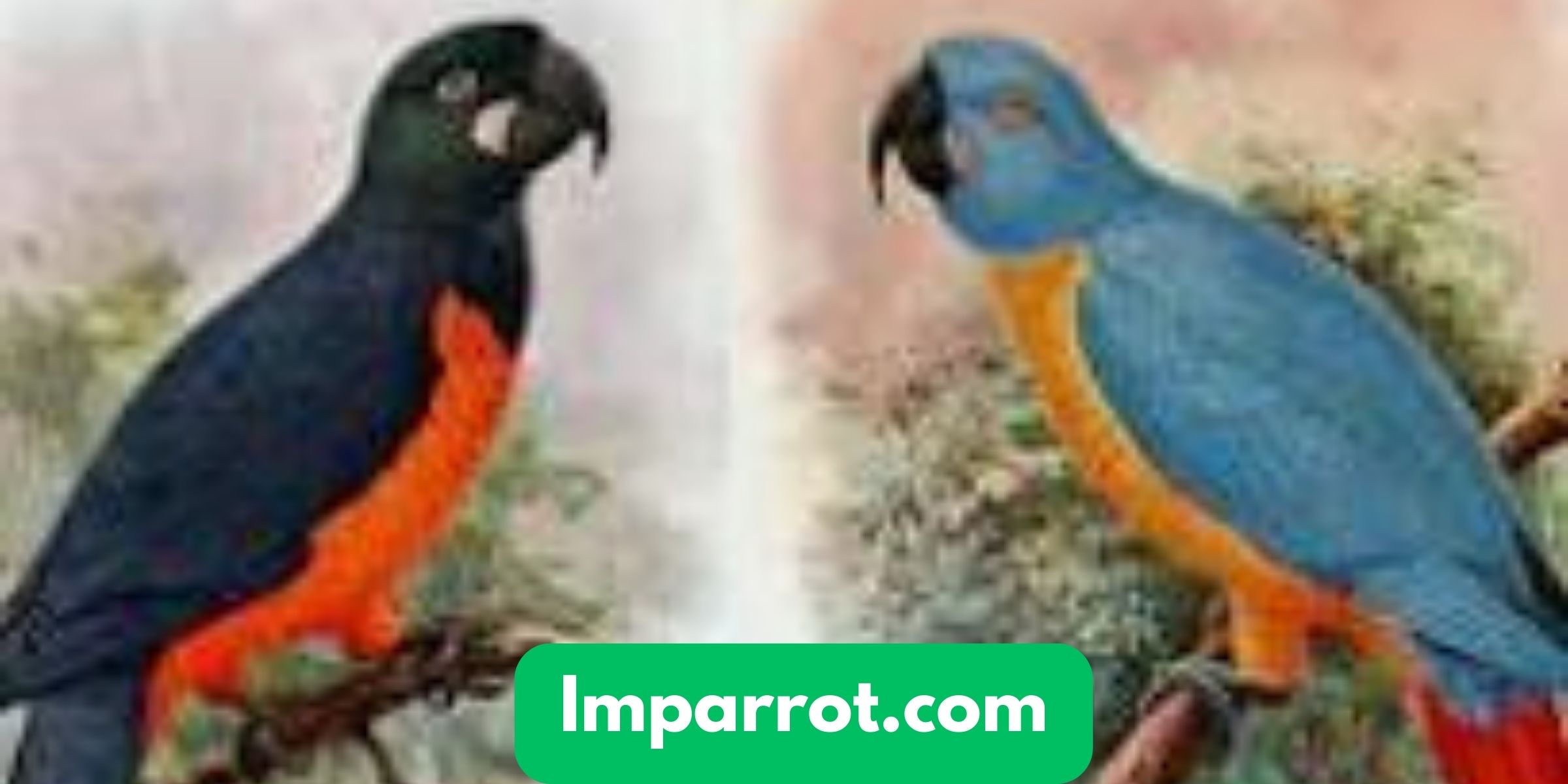Martinique Macaw (A Hypothetical Extinct Caribbean Macaw)
Last Updated on January 13, 2024 by Ali Shahid
There’s a hypothetical extinct macaw species known as the Martinique macaw or orange-bellied macaw (Ara martinicus) from the Caribbean island of Martinique. Officially recognized as Ara martinicus, this bird was initially chronicled by British zoologist Walter Rothschild in 1905, drawing from an account penned by French priest Jacques Bouton from the 17th century.
However, the authenticity of Martinique Macaw’s existence remains shrouded in uncertainty. The absence of tangible remains casts a shadow of doubt over its alleged presence. While historical records suggest the Caribbean islands might have hosted up to 13 distinct macaw species, only traces of three have been validated.
Complicating matters further is the historical intermingling of macaws between the Caribbean and South America, muddying the distinction between indigenous and introduced species. Nevertheless, the enigmatic aura surrounding the Martinique Macaw persists, enhancing its mystique and ensuring its legend endures, even in the absence of conclusive evidence.

Origin and History of Martinique Macaw
The Martinique macaw is believed by some experts to have once existed on the Lesser Antillean island of Martinique in the Caribbean. Although historical records mention this bird, there’s no physical evidence like bones or preserved birds to confirm its existence.
The first known image of the Martinique macaw comes from a painting by French priest Jacques Bouton in the 1630s. He described the bird as bigger than other parrots on the island, with bright blue and orange-yellow feathers. This description caught the interest of British scientist Walter Rothschild in 1905, who initially named it Anodorhynchus martinicus. However, he later changed the name to Ara martinicus in 1907, thinking the earlier name was just another way to say the same thing.
A surprising claim came in 1936 when Cuban scientist Mario Sánchez Roig said he found a stuffed Martinique macaw from 1845. But when experts looked closely, they found out it wasn’t real; it seemed to be made from parts of other birds.
Some bird experts, like Julian P. Hume and Michael Walters from Britain, think that another bird species called Ara erythrura might be what people were talking about when they mentioned the Martinique macaw. Although the Birdlife International database doesn’t recognize it as a separate bird species, it suggests a possible connection to another macaw species from the Lesser Antilles.
Looking at its family tree, the Martinique macaw belongs to the Ara genus, a group of macaws found in the Americas. The name ‘Ara’ comes from a word used by the Tupi people, reflecting the loud calls of these birds. The name ‘martinicus’ suggests it came from Martinique. Still, there’s an ongoing discussion among experts. Some believe that the bird in Bouton’s painting might have been a different kind of macaw brought to Martinique through trade.
Controversies Surrounding the Martinique Macaw
The Martinique Macaw has become a point of contention in scientific circles, mainly because there’s no concrete evidence to validate its existence. Walter Rothschild gave it its scientific name in 1905, drawing from Jacques Bouton’s 1630s depiction of a bird with “blue and orange-yellow” feathers. Yet, apart from this description, tangible proof is scanty. Some experts argue that what people might have seen could have been the blue-and-yellow macaws (Ara ararauna) instead.
Interestingly, the Martinique Macaw is just one of several macaw species believed to have once inhabited the Caribbean islands. However, skepticism looms large over many of these claims. Only three of these species have been backed by physical evidence, casting doubt on the existence of the others.
The plot thickens when considering the historical movement of macaws between the Caribbean islands and South America. This inter-island and mainland bird migration, both before and after European explorers arrived in the 15th century, muddles the waters. As a result, it’s challenging to discern whether old accounts are referring to native macaws or those brought in from elsewhere.
To bring clarity to this puzzling narrative, scientists believe that DNA analysis of ancient fossils and contemporary records will be instrumental. If the Martinique Macaw did walk the earth, some believe it might be synonymous with the “red-tailed blue-and-yellow macaw” (Ara erythrura), another species Rothschild named in 1907, based on a description from 1658.
Other Extinct Caribbean Macaw Species
The islands may have once been home to as many as 13 extinct macaw species. Physical remains have identified three species of endemic Caribbean macaws:
- 19 museum skins and subfossils of the Cuban macaw (Ara tricolor),
- Subfossils of the Saint Croix macaw (Ara autochthones),
- Reports on Lesser Antillean Macaws (Ara autochtones)
In historic and prehistoric times, humans drove endemic Caribbean macaws to extinction.
Today, many hypothetical extinct macaw species are considered dubious, based only on contemporary accounts. Rothschild, who named species based on little tangible evidence, named several of them in the early 20th century.
Jamaican red macaws (Ara gossei) and red-headed macaws (Ara erythrocephala) were named after macaws from Jamaica. A green-and-yellow macaw (Ara Atwood) is believed to be native to Dominica. A blue parrot supposedly from Guadeloupe was named for the violet macaw (Anodorhynchus purpurascens), now thought to be an Amazon violacea from Guadeloupe.
It has been reported that there are other species of macaw, but many of these have not received binomial designations, making them junior synonyms.
In 2008, an ornithology team rejected the idea that all Antillean islands possess endemic species. Hispaniola has a large land area, yet no macaw species exists. Some people believe it would have existed.
According to them, such a species may have disappeared before the arrival of the Europeans. Palaeontological discoveries and examination of contemporary reports and artwork will ultimately reveal the identity of indigenous macaws in the Caribbean.
Reasons Behind Their Extinction
A large part of the disappearance of these macaw species can be attributed to human activity, both ancient and recent. As humans settled in the Caribbean, they unintentionally moved and wiped out native parrot populations, including macaws. This has clouded our understanding of what the parrot communities looked like before human intervention.
Furthermore, factors like habitat loss, driven by human development, along with shifts in climate patterns, have critically affected macaw populations. Adding to this, the desire for these colorful birds as pets has led to significant declines in their wild numbers. Macaws, with their slow breeding cycles, struggle to replenish their numbers quickly when taken from the wild.
Historically, the regular movement of macaws between the Caribbean islands and South America by early Paleoamericans and later by European explorers in the 15th century, has added another layer of complexity. This constant back-and-forth makes it hard for researchers to distinguish between native and introduced species based on old records.
Moreover, the changing climate in the Caribbean is amplifying these challenges. Alterations in nesting areas, shifts in migration routes, and the increasing frequency of severe weather events, like stronger hurricanes linked to global warming, have further stressed these bird populations. When you combine these environmental shifts with direct human actions, it becomes clear why we no longer see any native macaws in the Caribbean today.
The Current Status of Macaws
Macaws, known for their colorful feathers and sharp minds, hail from Central and South America. Sadly, many macaw types face danger today, with some gone forever, like the Spix’s and glaucous macaws. The main culprits? Swiftly disappearing forests and illegal trading. Two well-known macaws, the Scarlet Macaw and the Great Green Macaw, capture our hearts but are dwindling in numbers.
Take the Scarlet Macaw: it once painted 85% of Costa Rica but now thrives in only two spots. Yet, there’s hope. The Blue-throated Macaw, believed lost, showed a positive trend in 2022 with 228 spotted in a single habitat. Still, the wild holds fewer than 200 of these birds.
Conservation Efforts
Numerous groups are actively committed to safeguarding macaw species. For instance, the Macaw Recovery Network focuses its efforts on preserving the Scarlet Macaw and the at-risk Great Green Macaw in Costa Rica. Meanwhile, the World Parrot Trust has been instrumental in stabilizing the dwindling populations of the critically endangered blue-throated macaw.
Further aiding the cause, the Indianapolis Zoo is constructing a field station within a newly established reserve. Additionally, in Costa Rica, the Association for Parrot Conservation spearheads initiatives specifically for the Scarlet Macaw. Not to be left behind, the Rainforest Trust diligently works to protect the natural habitats crucial for the survival of the Blue-throated Macaw.
Conclusion
The Martinique Macaw, painted with vibrant colors and shrouded in mystery, holds a special place in the hearts of scientists and bird lovers. Though solid evidence is scarce, old descriptions and scientific insights suggest its intriguing presence in the Caribbean’s ecological tapestry. This bird’s tale reflects a dance of human influence, shifting environments, and the intricacies of nature.
Controversies swirl around the Martinique Macaw, with discussions on its true identity and whether it’s simply a variation of the blue-and-yellow macaw. Such debates emphasize the challenges faced when discerning native species, especially in places like the Caribbean, where macaw movement was common. Highlighting the urgency of the matter, many macaws now teeter on the brink of extinction due to habitat loss and illicit trade.
While Martinique Macaw’s enigma endures, ongoing studies and technological breakthroughs, like DNA evaluations of ancient remains, could unveil clearer insights in the future. For now, this mysterious bird stands as a poignant symbol of the Caribbean’s once-abundant biodiversity and the pressing call to safeguard its remaining macaw treasures.

